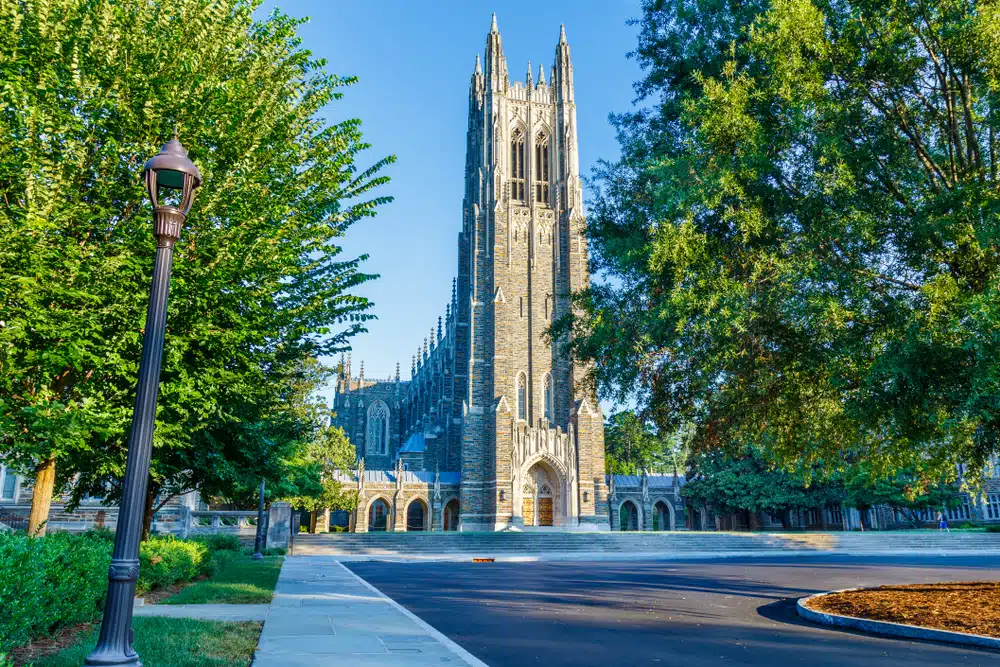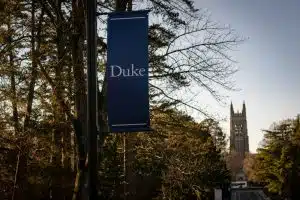Duke is a renowned educational institution with impressive size and reach. With its sprawling campus, diverse student population, and esteemed faculty, Duke University is a prominent institution globally.
This article will delve into Duke’s size and reach, examining its campus layout, student demographics, and faculty numbers. Additionally, we will explore how Duke’s influence extends beyond the confines of its campus, making an impact globally and locally.
Understanding the Size of Duke University
Campus Size and Layout
Located in Durham, North Carolina, Duke University boasts a picturesque campus spread across 8,600 acres. The physical layout is meticulously designed, combining Georgian-style architecture with modern facilities. Students and visitors are greeted with beautifully landscaped gardens, serene quads, and state-of-the-art academic buildings.
Walking through Duke’s campus, you’ll notice the careful attention to detail in every corner. The Georgian-style architecture, with its symmetrical facades and grand columns, creates a sense of elegance and tradition. The buildings seamlessly blend into the natural surroundings, with tree-lined pathways and open green spaces inviting students to relax and enjoy the beauty of their surroundings.
One of Duke’s campus highlights is the Sarah P. Duke Gardens, a stunning 55-acre oasis of botanical beauty. With its vibrant flowers, tranquil ponds, and winding paths, the gardens provide a peaceful retreat for students and visitors alike. Whether studying under a shady tree or taking a stroll, the parks offer a serene escape from the demands of academic life.
Beyond its academic spaces, Duke’s campus also features renowned libraries, laboratories, performance venues, and athletic facilities. With its vast collection of books and digital resources, the Perkins Library is a hub of knowledge and research.
The Fitzpatrick Center for Interdisciplinary Engineering, Medicine, and Applied Sciences provides cutting-edge research and collaboration facilities. The Cameron Indoor Stadium, home to the Duke Blue Devils basketball team, is a legendary venue that has witnessed countless thrilling games and championship victories.
Student Population
Duke University proudly hosts a diverse and vibrant student body, with over 15,000 students enrolled across undergraduate, graduate, and professional programs. This mix of talented individuals from around the world fosters an environment of cultural exchange and intellectual growth.
The undergraduate student population comprises approximately 6,600 students, representing all 50 states and over 100 countries. This rich diversity creates a vibrant community where students can learn from one another’s experiences and perspectives. Whether engaging in lively classroom discussions, participating in student organizations, or attending cultural events, Duke students have ample opportunities to broaden their horizons and develop a global mindset.
Furthermore, Duke University is committed to providing access to education for students from all backgrounds. The university’s financial aid programs ensure that talented students can pursue their academic dreams at Duke regardless of their financial circumstances. This commitment to inclusivity and equal opportunity is a cornerstone of Duke’s mission and values.
You’ll find many interests and passions within the student population. From aspiring scientists and engineers to budding artists and writers, Duke attracts driven and ambitious students in their respective fields. The university’s rigorous academic programs and extensive extracurricular opportunities provide a fertile ground for students to explore their interests, discover new passions, and develop the skills necessary for success in their chosen careers.
Faculty and Staff Numbers
At Duke University, students can learn from esteemed faculty members who are leaders in their respective fields. With a faculty-to-student ratio of 6:1, students receive personalized attention and guidance.
Duke employs more than 3,600 faculty members who bring their expertise and passion to the classrooms, laboratories, and research centers. These dedicated scholars and researchers engage in groundbreaking research, collaborate with colleagues globally, and inspire students to achieve their full potential.
Within the faculty, you’ll find Nobel laureates, Pulitzer Prize winners, and members of prestigious academic societies. Their accomplishments and contributions to their fields are not only impressive but also serve as an inspiration to students, fueling their aspirations for excellence.
Moreover, Duke’s faculty members are experts in their disciplines and committed mentors and advisors. They take a genuine interest in their student’s intellectual growth and personal development, guiding them through their academic journey and helping them navigate the complexities of their chosen fields.
Beyond the faculty, Duke University also employs a dedicated staff who work tirelessly behind the scenes to ensure the smooth functioning of the university. From administrative support to facilities management, these professionals play a crucial role in creating an environment where students can thrive and succeed.
With such a talented and dedicated faculty and staff, Duke University can provide a world-class education that prepares students for leadership and success in their chosen paths.
The Reach of Duke University
Global Presence and Influence
Beyond its physical boundaries, Duke University has established a robust global presence. The university connects with institutions worldwide through its numerous international programs and partnerships, facilitating international research collaborations, study-abroad opportunities, and academic exchanges.
For instance, Duke University has established collaborative research projects with universities in China, India, and Germany. These partnerships allow faculty members and students to engage in cross-cultural research initiatives, exploring diverse perspectives and approaches to solving global challenges.
Furthermore, Duke’s commitment to global engagement is evident in its extensive network of study-abroad programs. Students can immerse themselves in different cultures, gaining firsthand experiences and a deeper understanding of global issues. Whether studying marine biology in Australia or learning about sustainable development in Costa Rica, Duke students broaden their horizons and become global citizens.
This global outlook extends to Duke’s diverse student body, which brings together individuals with varied perspectives and cultural backgrounds. This exposure to different perspectives cultivates a worldwide mindset and prepares students to tackle complex challenges in an increasingly interconnected world.
Moreover, Duke University actively participates in international conferences and forums, where faculty members and students present their research findings and discuss with scholars worldwide. These interactions contribute to the exchange of ideas and the advancement of knowledge on a global scale.
Academic Reach and Reputation
As one of the most prestigious research universities in the United States, Duke’s academic reach extends far and wide. Its faculty members are renowned experts in various disciplines, conducting groundbreaking research that advances knowledge and addresses societal issues.
For example, Duke’s School of Medicine is at the forefront of medical research, pioneering innovative treatments and therapies. The university’s researchers have significantly contributed to cancer research, neurobiology, and genomics, revolutionizing how we understand and treat diseases.
Duke’s strong emphasis on interdisciplinary collaboration allows for innovative research initiatives that transcend traditional academic boundaries. Faculty members from different departments come together to tackle complex problems, combining their expertise to find comprehensive solutions.
Through conferences, symposiums, and publications, Duke’s intellectual pursuits have a far-reaching impact on academia and society. The university’s research findings are frequently published in prestigious journals, influencing the work of scholars and professionals worldwide.
Furthermore, Duke University is committed to fostering a vibrant intellectual community through its numerous academic centers and institutes. These centers serve as hubs for interdisciplinary research and provide resources and support for scholars working on cutting-edge projects.
Athletic Reach and Recognition
While Duke University is primarily known for its academic excellence, its athletic programs also command recognition on a national level. The Duke Blue Devils, the university’s athletic teams, compete in Division I of the NCAA and boast impressive victories and championships.
The athletic programs at Duke foster a culture of excellence and sportsmanship, attracting talented student-athletes who showcase their skills on a national stage. The university’s commitment to athletic success and integrity has resulted in a loyal fan base and recognition as a prominent institution in collegiate athletics.
Moreover, Duke’s athletic programs extend beyond the field or court. The university emphasizes balancing academics and athletics, providing student-athletes with the necessary support and resources to excel in both areas. Duke’s student-athletes are known for their dedication to their studies and commitment to positively impacting on and off the field.
Duke University’s athletic programs also contribute to the campus culture, fostering community and school spirit. The university’s athletic events, such as basketball games at Cameron Indoor Stadium, are highly anticipated and bring together students, faculty, alumni, and fans from all walks of life.
Furthermore, Duke’s athletic programs have produced numerous successful athletes who have achieved greatness in their respective sports. Many Duke alums have represented their countries in international competitions and have become role models for aspiring athletes.
The Impact of Duke University’s Size and Reach
Opportunities for Students
At Duke University, the size and reach of the institution translate into abundant opportunities for students. The diverse student body and the wide range of academic programs allow students to explore their interests, develop new skills, and expand their horizons.
With over 9,000 undergraduate and graduate students from all 50 states and over 100 countries, Duke University offers a truly global learning experience. Students can engage with peers from different backgrounds, cultures, and perspectives, fostering a prosperous and inclusive environment that prepares them for a globalized world.
Furthermore, Duke’s size allows for many extracurricular activities and organizations catering to diverse interests. From joining student-led clubs and organizations to participating in community service initiatives, students can find their niche and make a meaningful impact outside the classroom.
The university’s extensive network of alumni and corporate partners also provides students with internship and job opportunities, enabling them to embark on successful career paths upon graduation. Through career fairs, networking events, and mentorship programs, students can connect with professionals in their desired fields and gain valuable industry insights.
Moreover, Duke’s size and reach extend beyond the campus borders. The university’s study abroad programs allow students to immerse themselves in different cultures, languages, and academic systems, broadening their perspectives and fostering a global mindset.
Contributions to Research and Innovation
Duke’s size and reach are crucial in fostering an environment conducive to groundbreaking research and innovation. As researchers collaborate across disciplines and leverage the university’s resources, they significantly contribute to advancements in science, technology, healthcare, and numerous other fields.
With over 200 research centers and institutes, Duke University provides a fertile ground for interdisciplinary research. Whether studying the effects of climate change, developing new cancer treatments, or exploring the frontiers of artificial intelligence, Duke’s research efforts push the boundaries of knowledge and drive innovation.
The university’s commitment to research extends within its campus and partnerships with research institutions, government agencies, and industry leaders. Collaborative projects with organizations such as the National Institutes of Health, the World Health Organization, and leading pharmaceutical companies amplify the impact of Duke’s research efforts, facilitating knowledge transfer and driving real-world solutions.
Furthermore, Duke’s size and reach attract top-tier faculty and researchers worldwide. These experts bring their expertise, experience, and diverse perspectives, creating a vibrant intellectual community that fosters innovation and drives breakthrough discoveries.
Influence on Local and Global Communities
Duke University’s size and reach have a profound influence on both local and global communities. Through community engagement initiatives, the university addresses pressing social issues, collaborates with local organizations, and contributes to the well-being of the Durham community.
Through programs like DukeEngage, students can apply their knowledge and skills to impact the local community positively. Whether tutoring underprivileged students, working with nonprofit organizations, or participating in community development projects, Duke students actively contribute to the betterment of Durham and its residents.
On a global scale, Duke’s research, educational programs, and partnerships impact communities worldwide. From conducting research on global health challenges to implementing sustainable development projects in developing countries, Duke University catalyzes positive change beyond its campus borders.
Through its Global Duke initiatives, the university collaborates with international partners to address global challenges such as poverty, climate change, and access to education. These partnerships facilitate knowledge exchange, cultural understanding, and capacity-building, creating a network of change-makers committed to making a difference in the world.
Ready to Make Your Mark at Duke University? Let AdmissionSight Guide You There.
You’ve just delved deep into the sprawling campus, the extensive academic offerings, the vibrant student life, and the global reach of Duke University. Are you feeling overwhelmed? Don’t be. The journey to Duke might seem like a labyrinth, but with AdmissionSight, consider it a guided tour.
Why Choose Us?
- Expertise: We’re not just consultants but your academic cartographers, mapping out your route to Duke’s hallowed halls.
- Personalization: Forget one-size-fits-all; our services are as unique as you are.
- Success Stories: Hundreds of students have unlocked the doors to Duke and other elite institutions with our help. You could be next.
What’s Next?
- Consult: Schedule a free, no-obligation consultation to discuss your academic dreams.
- Strategize: Work one-on-one with our experts to craft a college application that’s as extraordinary as you are.
- Achieve: Submit your application and await that coveted acceptance letter from Duke.
Take the Leap. Don’t let the size of Duke intimidate you. Whether you’re an aspiring engineer, a future Rhodes Scholar, or the next big thing in college basketball, we’ve got the keys to unlock your potential.









































